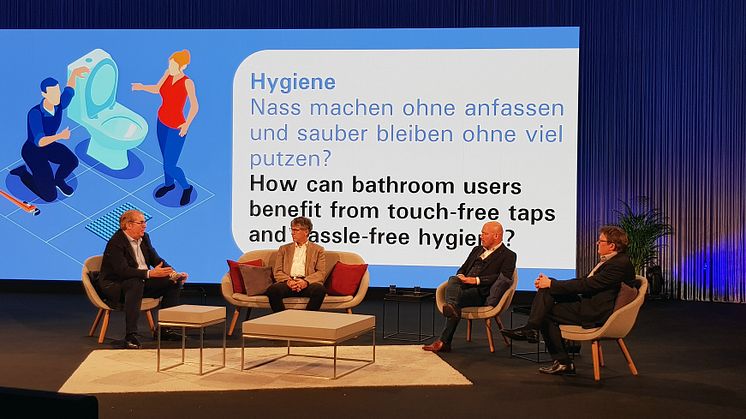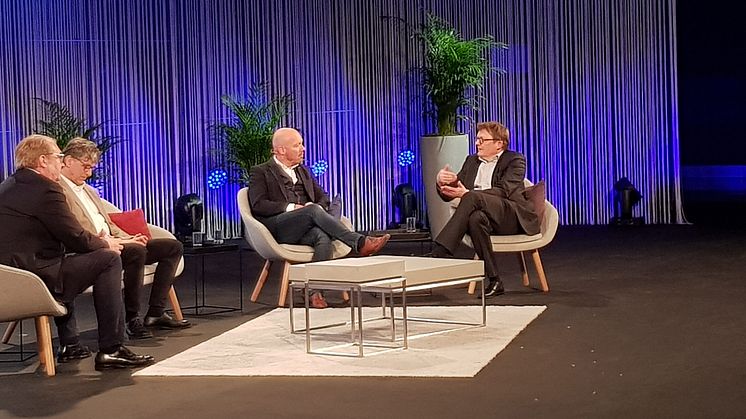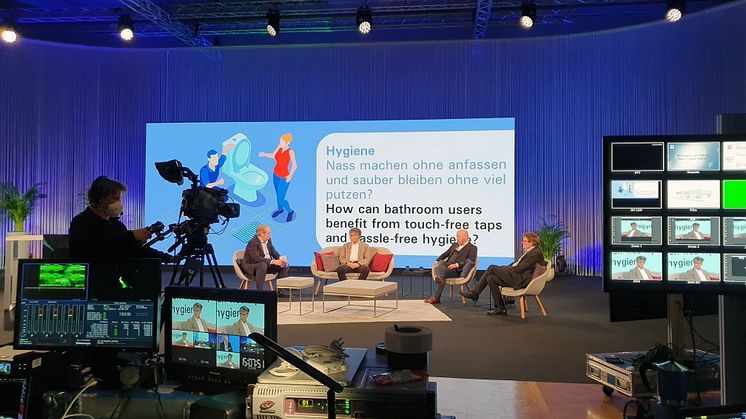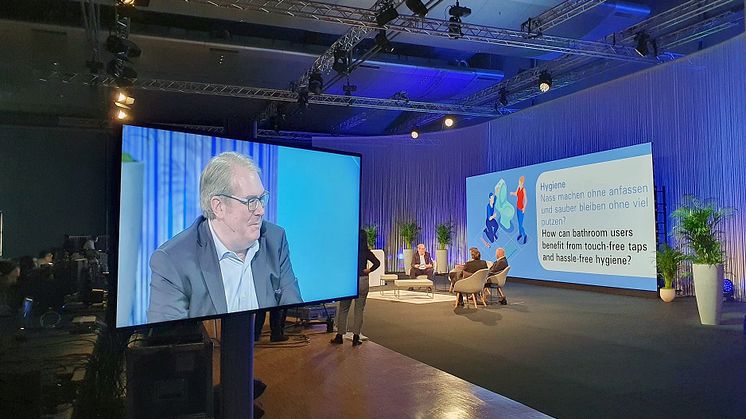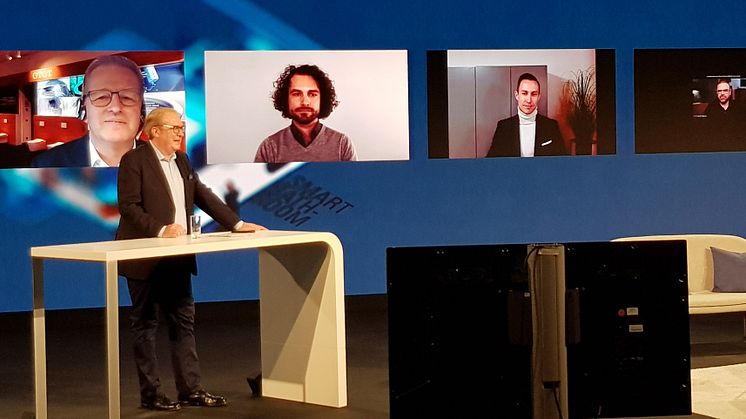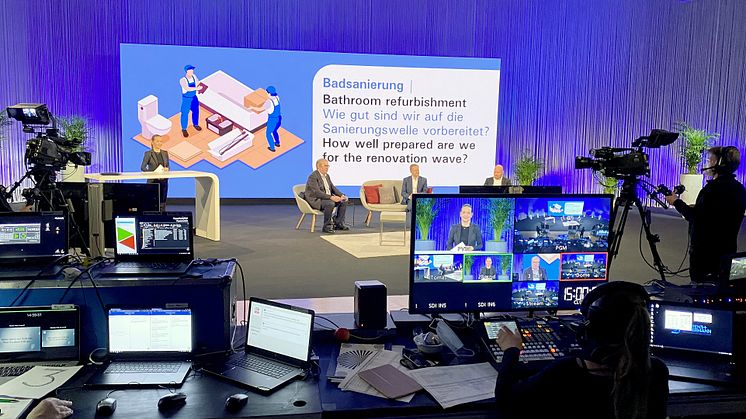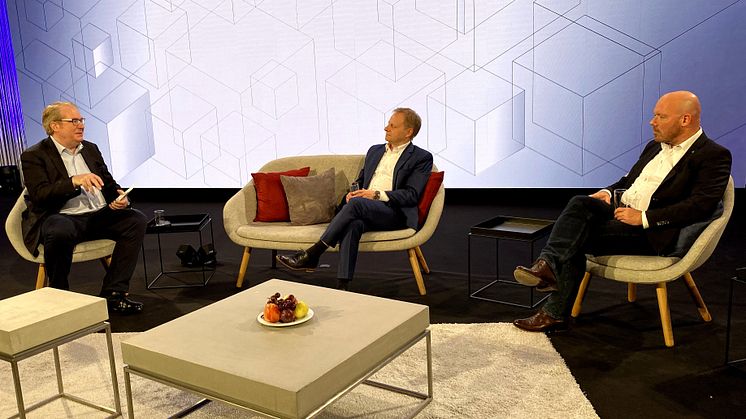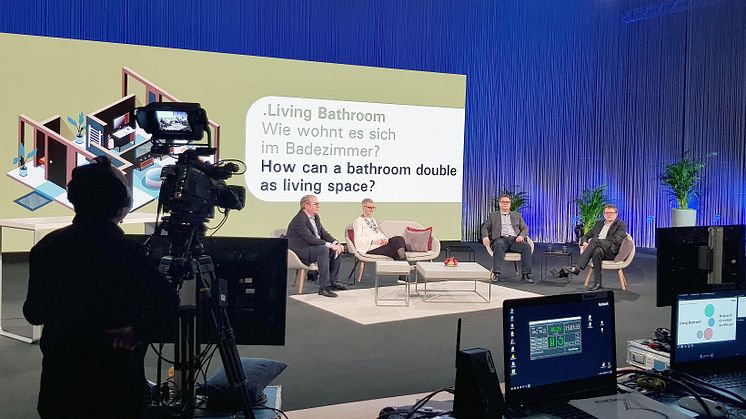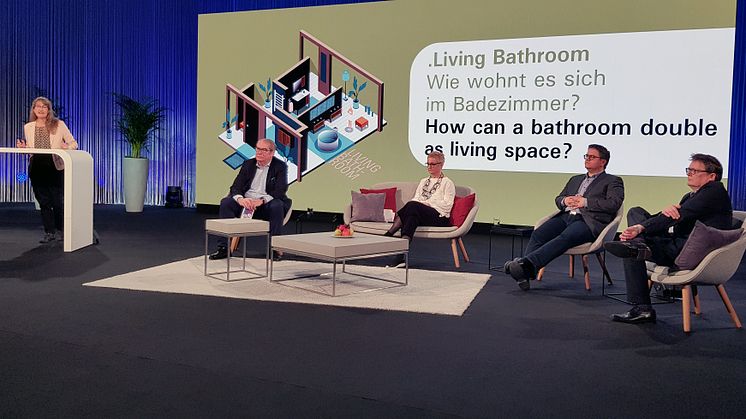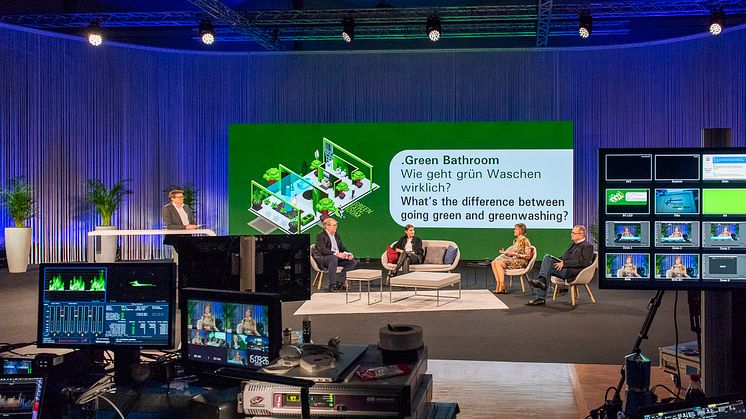
Press release -
Pop up my Bathroom Magazine: 5 days live from ISH digital 2021
In the live stream format Pop up my Bathroom Magazine, the information platform for creative bathroom planning, architecture and design, representatives from the bathroom industry and trades, creatives and planners discussed the sector’s most important trends during the ISH digital 2021.
The ISH digital 2021 convinced exhibitors and visitors alike with its smooth performance and positive resonance. While the intensity of the trade fair experience can’t be replicated by digital events, the ISH digital compensated in other ways: with an impressive array of events and content, video streams from exhibitors and matchmaking.
In the Water segment, the Pop up my Bathroom Magazine emerged as one of the ISH digital 2021’s most popular formats. For years now, the lecture forum of the Pop up my Bathroom initiative established by the German Bathroom Sector Association (Vereinigung Deutsche Sanitärwirtschaft e.V. [VDS]) and Messe Frankfurt has been an integral part of the world’s leading trade fair for water, heating and air-conditioning. “That’s why translating the programme into the digital sphere and enabling the expert discourse on the trend topics we’ve put forward to take place under the new conditions seemed like the obvious decision,” explains Managing Director of the VDS Jens J. Wischmann. “We’re delighted that we received the ISH’s full support for the project. Besides being able to broadcast from our own studio, we were also able to implement our exhibition, which meant the three trends – Green Bathroom, Smart Bathroom and Living Bathroom – could be included in the Pop up my Bathroom Magazine as real, physical reference material.” The Inside | Outside trend showcase was integrated into the digital ISH platform in the form of a 360-degree tour and can subsequently be visited on the Pop up my Bathroom website.
The Pop up my Bathroom Magazine broadcast a live, 45-minute programme on every day of the event. In a total of five live streams with up to five interesting talk guests (some of whom joined the conversation online) and pre-produced video clips, each of the featured topics was explored from several angles. All the programmes can be viewed in full length on Pop up my Bathroom’s new YouTube channel.
Pop up my Bathroom Magazine showed the need to adapt to processes that are affecting society as a whole
Even though the live TV format couldn’t replace the direct exchange that takes place at the trade fair, it nevertheless succeeded in painting an authentic picture of the trends, challenges and opportunities that are impacting and driving the sector in spring 2021. It also documented the sometimes high level of commitment the industry is demonstrating in its engagement with these issues.
“The driving forces that have been our focus for some time now and which will continue to dominate the bathroom’s evolution for the next few years are sustainability, the smart home and cosiness,” says Frank A. Reinhardt, summing up the trend topics presented in the Magazine. In particular, he continues, the latter of the three trends – cosiness – has become even more important for people as a result of the sense of danger and the mobility restrictions they have been living with for the last year. But the need for hygiene and the desire to renovate are also drivers that have been fuelled by the pandemic experience, says the co-initiator of Pop up my Bathroom.
The Pop up my Bathroom Magazine took a look into the future of a sector that is increasingly being influenced by processes that affect the whole of society, such as the climate debate, demographic developments, urbanisation and health protection – processes that call for all the market partners involved to adapt accordingly. “All in all – as is also apparent from our Business Barometer study for the building equipment sector – we in the bathroom sector have a relatively privileged starting position from which to benefit from the economic recovery this year and help get Germany’s economic engine back to full power,” believes Jens J. Wischmann. “And that’s exactly what we need in order to maintain the sector’s current high level.”
Green Bathroom: What’s the difference between going green and greenwashing?
Green Bathroom was the opening topic for the Pop up my Bathroom Magazine live streams from the ISH digital 2021. And what an important topic it is – “especially with regard to the subject of climate goals, which is very much on our minds here at the ISH digital 2021,” as ISH presenter Carina Bastuck pointed out in her introduction. But what makes for a genuinely sustainable bathroom, and how are exhibitors implementing it? Jens J. Wischmann, Managing Director of the German Bathroom Sector Association (Vereinigung Deutsche Sanitärwirtschaft e.V. [VDS]) and – together with Messe Frankfurt – initiator of the Pop up my Bathroom Magazine, explored the answers to these and other questions together with three experts who joined him in the studio.
As Yvonne Piu, Head of Marketing at Kaldewei, explained: “On the one hand, it goes without saying that durability, or the useful life of a product, plays an important role. And on the other hand, there’s the question of what to do with it afterwards. At Kaldewei, we take a very in-depth approach to the subject and have been thinking about how we can develop a circular raw material for a long time now.” Kaldewei’s steel enamel products are designed for a long lifespan of approx. 30 to 40 years and are then 100% recyclable, meaning that the material can be used to make the same product again.
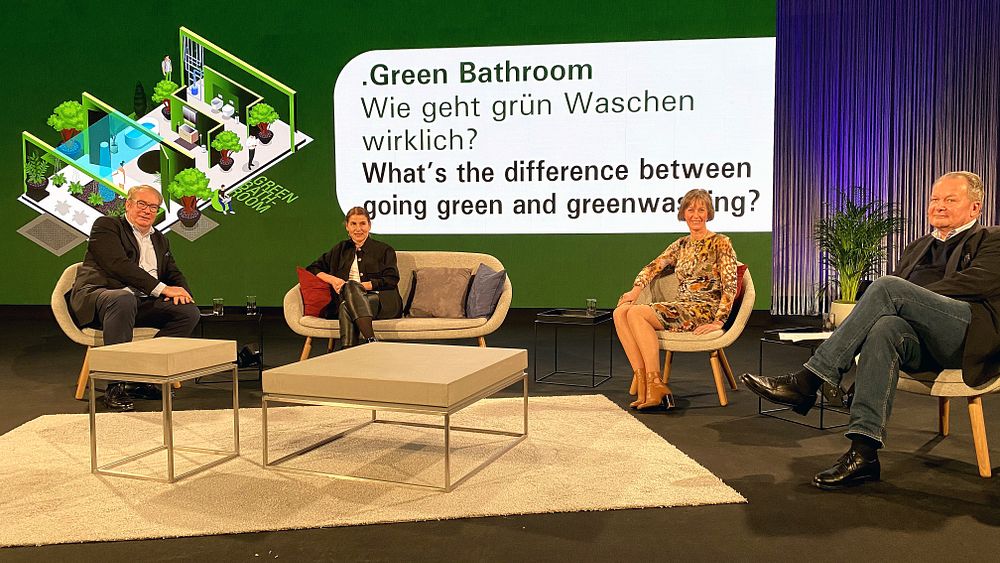
For sustainability expert Dr Susanne Sollner, Head of Innovation/Sustainability Management at bathroom furniture specialist burgbad, the term sustainability spans three different areas: profitability, social aspects and ecology. “The only way to develop the theme and set yourself action areas – whether that means climate protection, resource conservation or the global supply chain – is to take a strategic approach to the overall subject. Then you can show that something is verifiably sustainable – which obviously means backing it up with certification as well.” Take burgbad’s bestselling Eqio series, for example: it was awarded the Blue Angel late last year. The eco-label certifies that the bathroom furniture collection is made of low-emission materials, only uses wood from sustainably managed forests and has no adverse impact on health in the living environment. In addition, burgbad has been certified as a climate-neutral furniture manufacturer since 2016 and carries other labels that verify the company’s sustainable and ecological practices.
For Wolfgang Burchard, on the other hand – Managing Director of the VDMA’s Valves / Welding and Pressure Gas Equipment associations, and as such a representative of the fittings industry – the sustainability question should focus on the quality of drinking water: “On the one hand, what goes into the pipe should come out of the pipe unchanged. And on the other, we don’t want to waste water – even though we in Germany are lucky in that we have enough.” Responsible handling of this vital resource is essential; that starts with sustainable design – in the sense of design that doesn’t chase passing fashions that are no longer popular a year later – but also includes quality and materials – which play a significant role with regard to the products both in front of and behind the wall. As Jens J. Wischmann concluded:
“It’s clear that sustainable thinking and sustainability aren’t just a job for product development; they’re issues that involve the entire company.” And that doesn’t only apply to the manufacturer’s side of the equation, as was apparent from a clip featuring Sebastian Fuchs Bad & Heizung, a bathroom and heating company from the skilled trades sector. Simon Schlese, Commercial Project Manager, explained how, among other things, the firm plants trees to ensure a low carbon footprint and how advising customers on sustainability can work. Last but not least, Hannes Bäuerle, Managing Director of Raumprobe, an online materials database and physical materials exhibition in Stuttgart, joined the conversation by video to give some examples of the valuable ways in which modern materials can contribute to a green bathroom. “Especially in the bathroom,” Bäuerle emphasised, “a multisensory experience plays an extremely important role. We experience materials from the top of our head all the way down to the soles of our feet. And that only makes selecting the right materials all the more important and relevant.” And those materials should be as kind to the user as they are to the environment.
The lessons from the first day of the Pop up Magazine: the Green Bathroom and sustainability are topics that have already been accompanying the bathroom sector for a long time and permit many different approaches; both manufacturers and the skilled trades are adopting different areas of focus. At the same time, companies are becoming increasingly aware of the need to make sustainable practices and thinking transparent and communicate their commitment to users.
Hygiene: How can bathroom users benefit from touch-free taps and hassle-free hygiene?
What does modern hygiene in the bathroom look like? That’s the topic host Jens J. Wischmann (VDS) and his three talk guests turned their attention to in the Pop up my Bathroom Magazine programme on the second day of the ISH digital 2021. While it’s certainly not a new topic in relation to the bathroom, the corona pandemic has brought hygiene back into focus. Nevertheless, according to trend researcher and co-organiser of the forum Frank A. Reinhardt (owner FAR.consulting), it would be wrong to call hygiene a trend. Instead, said Reinhardt, in terms of its dynamism and function, “hygiene-related themes should be understood as a trend driver that is very definitely having an impact on all other trends right now, including those featured here.”
However that may be, the corona pandemic has taken the importance of hygiene to a new level – as was confirmed by Dr Peter Arens, Senior Consultant Hygiene Manager at Schell and a microbiologist: “That’s very noticeable. Sales of electronic fittings have increased several times over. The connection is obvious: even when there’s no pandemic, it doesn’t make sense to use the basin mixer to wash your hands thoroughly after going to the toilet and then touch the contaminated lever again afterwards.”
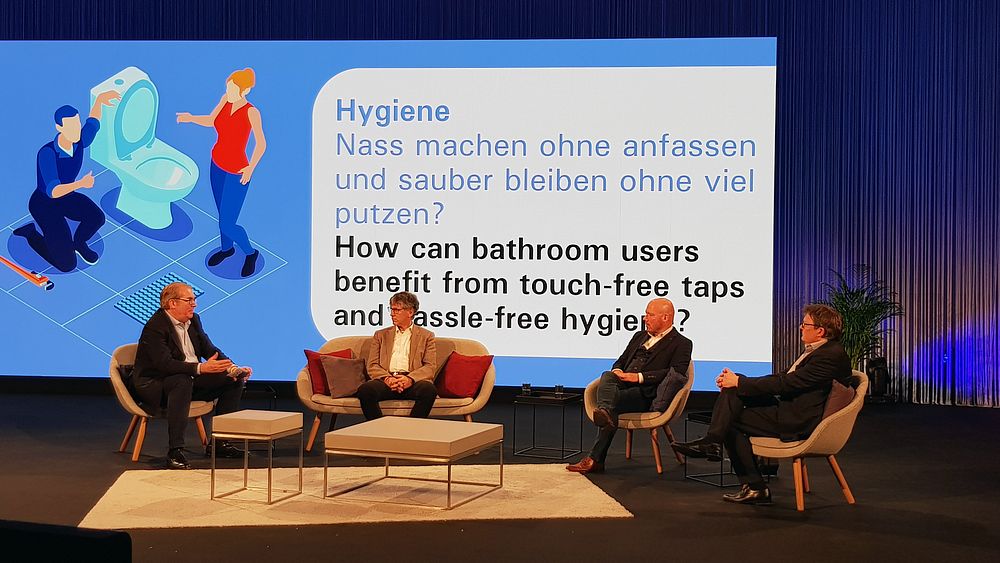
But the issue of drinking water quality is very much in focus too, especially in pandemic times, because when plumbing systems aren’t used – in offices that are deserted for weeks on end, for example – it can result in an increased build-up of bacteria and subsequently lead to severe disease. To counteract that, explained Peter Arens, the water needs to be changed every three days. Wischmann asked his guests what technical options are available if that can’t be done manually. “In terms of planning and installation, the industry can take care of that via good, sensible products,” said Dirk Engelhardt, Regional Sales Director Technology at Geberit. “And I believe the trades and bathroom planners can do the same. It’s the building operators I’m not sure about – regardless of whether they’re professional or private,” Engelhardt admitted. That’s why it’s so important to raise awareness among operators – and the trades can help in that respect too.
Hygiene in the bathroom also means personal hygiene. In response to the host’s provocative question as to whether Germans attach more importance to the cleanliness of their toilets than to that of their backsides, since rimless toilets have become increasingly popular in recent years, but shower toilets less so, Engelhardt replied: “It’s a combination of different things.” He pointed to current toilet cleaning habits, the higher price of shower toilets and the sensitive issue of intimate hygiene, which many planners and tradespeople used to find embarrassing. But, he added, it’s evident that selling shower toilets is becoming increasingly attractive for the trades and that customers’ own experiences with shower toilets – when travelling in Asia, for instance – is also strengthening demand. Ultimately, Dirk Engelhardt was optimistic: “We’re not where we want to be yet, but we’re on the right track.”
And last but not least, hygiene also plays an important role in the Living Bathroom, one of the three trends proclaimed by the Pop up my Bathroom forum: “With Living Bathroom, we want to enhance the quality of the time people spend in their bathrooms. We’re spending longer in the bathroom, so we might want a rug in there, for instance. That obviously means making sure the rug is washable and is replaced a bit more often than the usual 10 or 15 years,” observed Frank A. Reinhardt. On the whole, added the trend researcher, bathroom equipment – even in private homes – has become more hygienic per se thanks to dirt-repellent and antibacterial finishes. But he believes electrification has the greatest role to play when it comes to creating hygiene-promoting conditions, even in a cosy private bathroom: “In the meantime, the products and innovations that are already available on the market mean it’s possible to create an entirely touchless private bathroom, which is a huge bonus in terms of hygiene.” That ranges from sensor-controlled toilet lids, touchless taps and contact-free flush plates all the way to electronic soap dispensers. A family of four that washes its hands an average of 50 times a day can save a considerable amount of water and optimise routines. “That’s an interesting basis for planning a bathroom, as well as for architects and fitters when they bring this aspect into their consultations with customers,” said Reinhardt.
Smart Bathroom: What does the bathroom of the future look like today?
As if deliberately arranged to reflect the Smart Bathroom subject matter, all the guests who joined host Jens J. Wischmann, Managing Director of the German Bathroom Sector Association (Vereinigung Deutsche Sanitärwirtschaft e.V. [VDS]), on the third day of the Pop up my Bathroom Magazine at the ISH digital 2021 did so online. The clip featuring the Pop up my Bathroom trend showcase on new technologies in the bathroom illustrated just how smart our bathrooms already are – or can be if we choose.
Whereas just a few years ago the focus was still on individual products, nowadays it’s more about creating an intense overall experience. More attention is being paid to components like lighting, temperature, media and staging water, and the individual aspects are being coordinated with one another as well. But generally speaking, what can smart technology do today, and what should it be able to do?
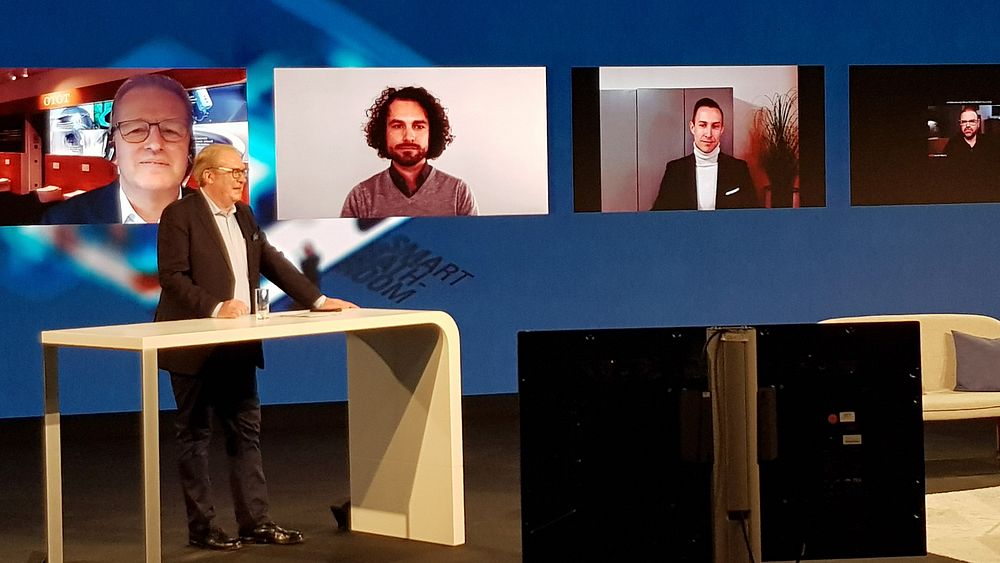
“Ultimately it’s about focusing on the user and their needs,” said Fabian Kinzler, Business Unit Manager | Business Unit Digital at Hansgrohe, summing up his company’s approach to smart technology. Although there are lots of gimmicks on the market, he added, it’s important for these technologies not to get out of hand, especially in the bathroom: what really matters is the added value they deliver for the user. In the bathroom, believes Kinzler, technology should at most be used additively and to provide support.
Matthais Oesterle, Design Director at Phoenix Design, takes a similar view and pointed to the controversy surrounding voice control in the bathroom: “A lot of people still find the idea disgusting, whereas others revel in it and think it’s great. Time will tell whether it catches on.”
But smart technologies are conquering the space behind the wall too, as Fabian Kinzler of Hansgrohe reported: “Every year, more than 1.2 million cases of water damage due to broken or leaking pipes are reported to insurers. And it’s not just a question of the material cost for the insurer; there’s an emotional cost for the people who depend on the bathroom too: sometimes they can’t use it for several weeks. We have a smart leak protection system in our portfolio that’s designed to identify the damage early on so that action can be taken at an early stage.”
Toto defines smartness in the bathroom more as a private matter that doesn’t take place online. That approach focuses on the idea of omotenashi, the Japanese word for hospitality. In this case, smartness means for instance that the toilet lid opens automatically and initiates a pre-cleaning process. But Toto also aims to promote wellness via the toilet, “by having it provide complete analysis of usage behaviour and analyse excretions, thus providing results that can help the user lead a better life,” as Hubertus Brüggemann, Sales Director German Markets, Toto Europe, explained.
The bathroom is used in diverse ways – by different generations, for relaxation and hygiene, for health and grooming, but also for entertainment. “For me, the bathroom is the most exciting room in the home because so much happens there,” said Birgid Eberhardt, Director Smart Home / AAL (Ambient Assisted Living) at housing development and construction company Gesellschaft für Siedlungs- und Wohnungsbau Baden-Württemberg (GSW). She pointed out that sensor technology and pre-set thermostats for different users (which are particularly appreciated by nursing staff and caregivers), as well as entertainment devices, don’t work on an analogue basis. Her credo: “In the Smart Bathroom we need electricity, electricity, electricity! We need electricity in the bathroom more than in any other room. And that should be taken into consideration at the planning stage, because retrofitting the bathroom is expensive. Anything I don’t factor in right from the start will put obstacles in my way in the future. And the future is now!”
The bottom line of the discussion? A bathroom should only ever be as smart as is beneficial for its users – because the bathroom is still regarded as a retreat within the home, where we’re sometimes quite content to forget all about our smart gimmicks for a while. Even so, it’s important to take smart applications into account when the bathroom is still at the planning stage. Or as bathroom expert Thorsten Moortz so aptly put it: “I hope bathroom planners will keep what we’ve been discussing here in mind. Because integrating and harmonising smart applications is precisely what a smart bathroom planner should be doing.”
Bathroom refurbishment: How well prepared are we for the renovation wave?
The renovation wave is in full swing – that’s undisputed. And as a study by B+L Marktdaten (presented by Managing Director Martin Langen of B+L Marktdaten in a video) confirms, the bathroom is leading the field, accounting for close to 42% of refurbishment measures. What’s more, the budgets deployed for renewing bathroom furnishings and sanitaryware have been increasing continuously since 2014. Which, as presenter Jens J. Wischmann, Managing Director of the German Bathroom Sector Association (Vereinigung Deutsche Sanitärwirtschaft e.V. [VDS]), remarked in his introduction, is a clear indication that Germans’ interest in their bathrooms has greatly increased.
The market outlook is definitely positive, then. Up until now, the bathroom sector has come through the corona crisis well. Jörg Pütz, owner of Puetz Marketing To Grow, agrees: “I’m in constant contact with tradespeople, and in some cases their companies had up to 30% more contracts than in 2019.” According to the market data that the VDS gathered together with Messe Frankfurt and the VDZ (Germany’s umbrella association for building technology), the sector as a whole reported a 5% increase in turnover for 2020.
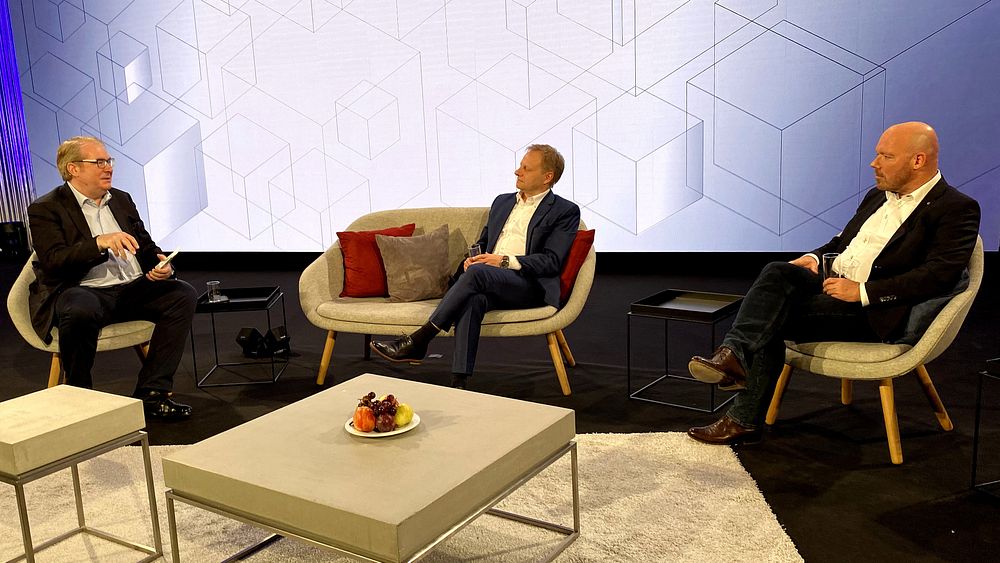
But is the sector sufficiently prepared for the renovation wave – especially in view of trends like sustainability and the smart bathroom? “To be honest, no,” answered Jörg Pütz candidly. “Because of the lack of skilled workers and insufficient capacities when it comes to fitters, the implementation side of things is a limiting factor right now, unfortunately.” Support could come from firms that are otherwise more active in the public or semi-public sphere. “We’ll have to see how things develop after Covid,” said Dirk Engelhardt, Regional Sales Director Technology at Geberit, with a cautious eye to the future. “Perhaps companies from the skilled trades sector who are more active in this area will have more capacity – even if they tend to be set up to deal with large-scale projects,” said Engelhardt, hoping for support from this quarter.
As for the issue of smartness in the bathroom, Pütz is confident that the processes involved will become smarter too: “Nowadays a lot of fitters are digital-savvy themselves, up to the point where they create digital platforms for bringing the different trades together so that bathroom projects can be coordinated better. That can mean a time saving of up to 70% in the planning phase and up to 20% in the construction phase.”
Integrated solutions are also available on the product side, especially when it comes to the interfaces – such as between installation and tiles. Prefabrication is another important aspect and plays a particularly important role in large-scale projects, although it’s also a great way for smaller companies to excel when fitting out individual bathrooms. “I can make up a GIS wall in the company workshop, load it into my van, drive to the client and screw it into the wall,” said Engelhardt of the benefits such solutions provide. “That’s a lot more professional, faster and more likely to achieve the desired result than sawing the profiles to size in the customer’s garden.”
A lot of users find inspiration for their new bathroom in hotels, where interesting bathroom projects are often implemented in the smallest of spaces – and then serve as models for upscale private bathrooms. “Even less expensive hotels are well equipped these days; they often feature solutions that stay in guests’ minds when they go home and provide them with ideas for what they want implemented in their own bathrooms,” said Stefan Hoske, Senior Consultant Architecture + Design at AXOR.
All in all, it seems as if the HVAC and bathroom sector has every reason to be optimistic about the renovation wave, and that both the trades and manufacturers are making every effort to resolve the shortage of skilled workers.
Living Bathroom: How can a bathroom double as living space?
“Today we’re talking about the living room … No: we’re talking about the bathroom,” said ISH presenter Carina Bastuck in her introduction to the cosiest of the topics featured in the Pop up my Bathroom Magazine. On the final day of the ISH digital 2021, the programme focused on the Living Bathroom trend. Having been in evidence at the world-leading ISH trade fair for some years, this trend is now entering the decisive round and changing the way private bathrooms are planned all over the world.
In a video statement, bathroom, spa and interior design specialist Torsten Müller called for bathroom planning to be rigorously human-centred: “We’re living in such fast-moving times that the bathroom has become a place of retreat, a kind of haven – a place that we should be able to experience with all five senses.”
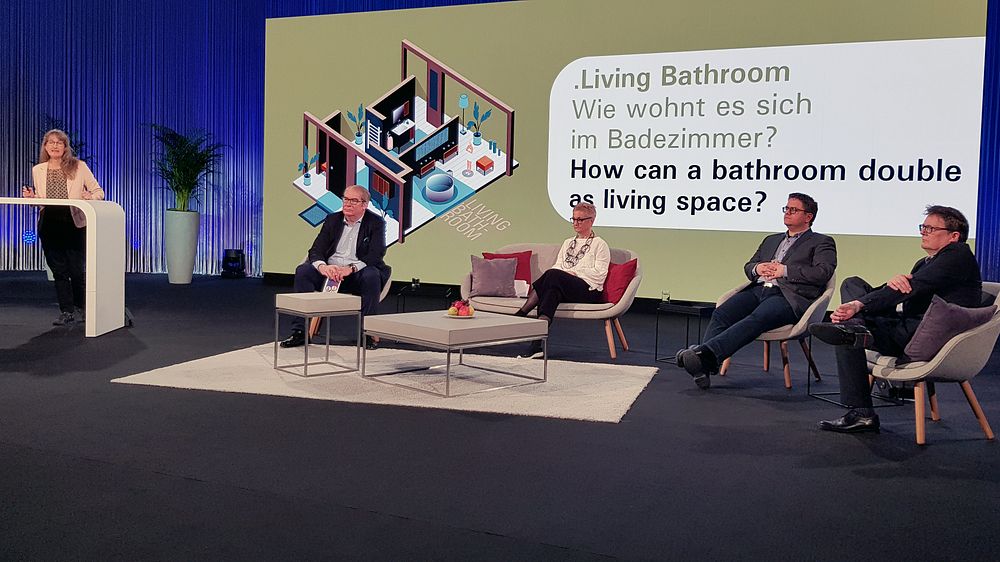
Christian Wadsack, an interior designer, planner and speaker at the firm ho.w Innenarchitektur, emphasised that it’s not only the furnishings and sanitaryware that need to be designed accordingly in a Living Bathroom; ideally, the planning should include the layout of the bathroom and the positioning of rooms within the floor plan as well. “For years now, when it comes to the evolution of the Living Bathroom, we’ve been observing that the space allocated to the bathroom in standard buildings is still far too small.”
With the right planning, however, a cosy bathroom can be created even in a small space, as demonstrated by interior designer Andrea Wirges-Klein (Wirges-Klein Architekten): she presented a project in a 19th-century house where the space couldn’t be increased because of the building’s heritage-protected status. “When you’re planning a Living Bathroom, the feel-good factor plays a crucial role. Finding the right combination of functionality, materials and emotionality is the biggest challenge – but it’s also what makes planning a modern lifestyle bathroom so incredibly interesting.”
Host Jens J. Wischmann, Managing Director of the German Bathroom Sector Association (Vereinigung Deutsche Sanitärwirtschaft e.V. [VDS]), was impressed by the level of complexity and cooperation between different trades that this kind of project involves: “A Living Bathroom has to be based on a holistic approach to planning. The many different requirements a planner has to meet when creating a private spa call for the involvement of a corresponding number of different talents.”
Denis Jäger, editor-in-chief of SBZ, a trade journal for the HVAC and bathroom sector, pointed to the increased requirements the sector’s trades have to satisfy: “The ‘universal genius’, the multitalented, all-round bathroom planner, is like a little Leonardo Da Vinci – they know their materials and tools, they know all about colours and the relevant technology, and they have to be capable of getting customers on board. Our sector’s bathroom planners have to be able to meet all those requirements – otherwise customers will just opt for an off-the-peg bathroom.”
Trend researcher and design journalist Frank A. Reinhardt’s (owner FAR.consulting) enthusiastic comment on the diverse topics involved with bathroom planning: “There are all sorts of stories a bathroom planner can tell, from sustainability or a smart bathroom all the way to a highly individual interior design. The increasing degree of cosiness people want in their bathrooms is the common denominator.”
Colour expert Dr Hildegard Kalthegener (Farbstudio Dr. K) provided some interesting insight into trend colours: “The wonderful colour blue that expresses the power of water as a natural force is nowhere to be seen in most bathroom showrooms. Black is being propagated as an on-trend colour for the kitchen and bathroom, but to me it seems more like a marketing gag than a genuine sales driver. There’s so much more you can do with colour in terms of generating an atmosphere and emotions,” she said, appealing to bathroom planners to make more active use of colour. Asked by Jens J. Wischmann how to inspire confidence when it comes to colour, the expert responded: “I can only encourage every bathroom planner, tradesperson or architect to try: using colour is something you can learn. You don’t have to experiment; you just need to address the theme of colour in the early stages of a project.”
The Pop up Magazine’s conclusion? A Living Bathroom is all about creating a more sensuous experience in the bathroom; it’s a question of identifying users’ needs and reflecting them in the form of a holistic bathroom design. The bathroom has to suit its users, and right now the Living Bathroom is the planning model with the greatest common denominator.
Further information:
ISH digital 2021 website: https://ish.messefrankfurt.com
Pop up my Bathroom website: www.pop-up-my-bathroom.com
Editor’s note
All the Pop up my Bathroom Magazine broadcasts for the ISH digital 2021 can be viewed in two languages on the Pop up my Bathroom YouTube channel and integrated into websites: Pop up my Bathroom - YouTube
Related links
Topics
Categories
Pop up my Bathroom, an initiative of the German Sanitary Industry Association (Vereinigung Deutsche Sanitärwirtschaft e.V. [VDS]) and Messe Frankfurt established in conjunction with the ISH, is an experimental platform for architects, bathroom planners, interior designers and journalists. It aims to explore and illustrate what possibilities the bathroom can offer people as an aesthetic and functional space. On the one hand, it gives experts a chance to find out about new developments, on the other hand it aims to convert the designs it develops into pictures that will be understood all over the world. The website www.pop-up-my-bathroom.com has therefore been expanded into a continuously updated blog that serves as a communication platform and has attracted almost 1 million international visitors. Until the next ISH opens its doors, it informs professionals and interested consumers not just about the Pop up my Bathroom trends but about the latest developments in various segments of the sanitary industry as well.



